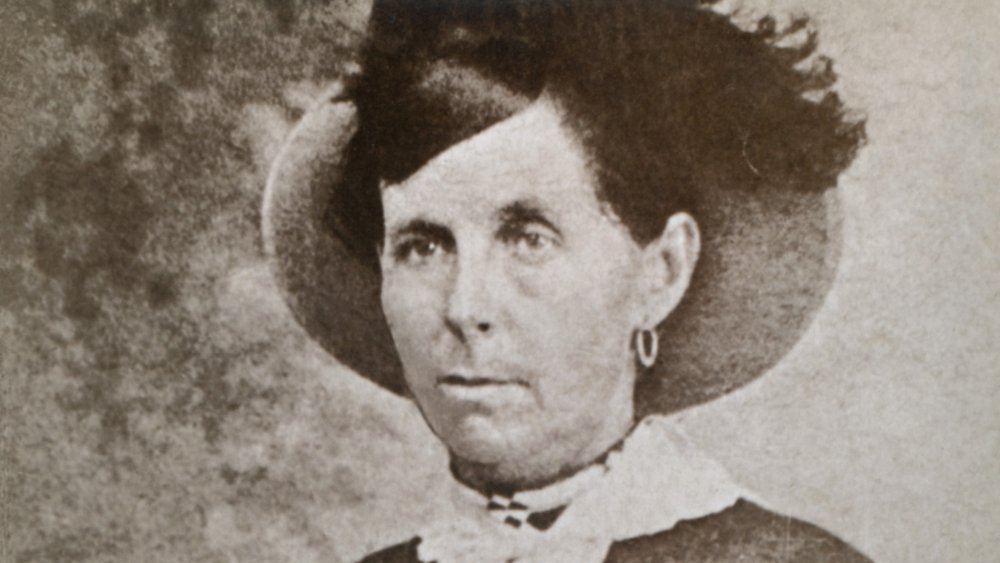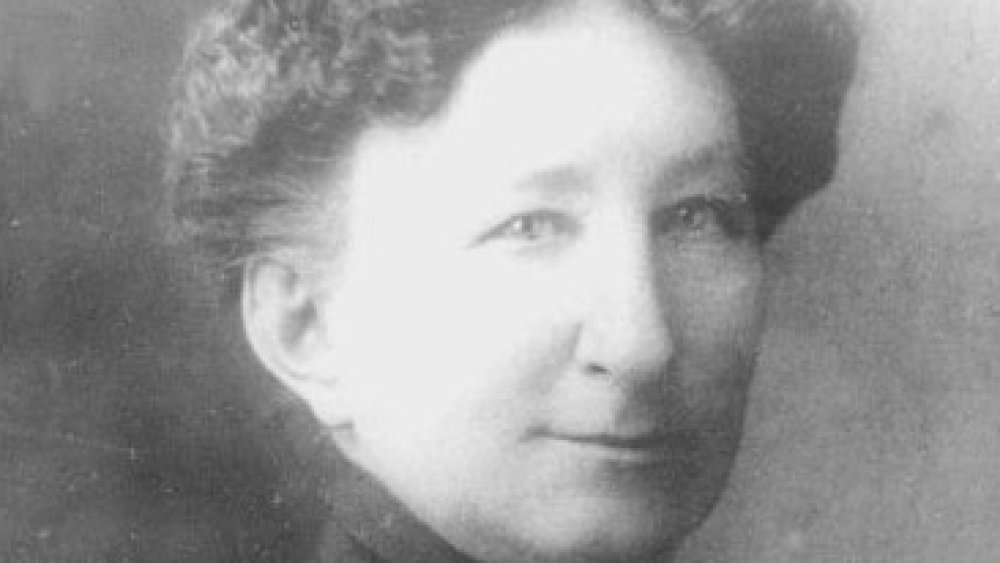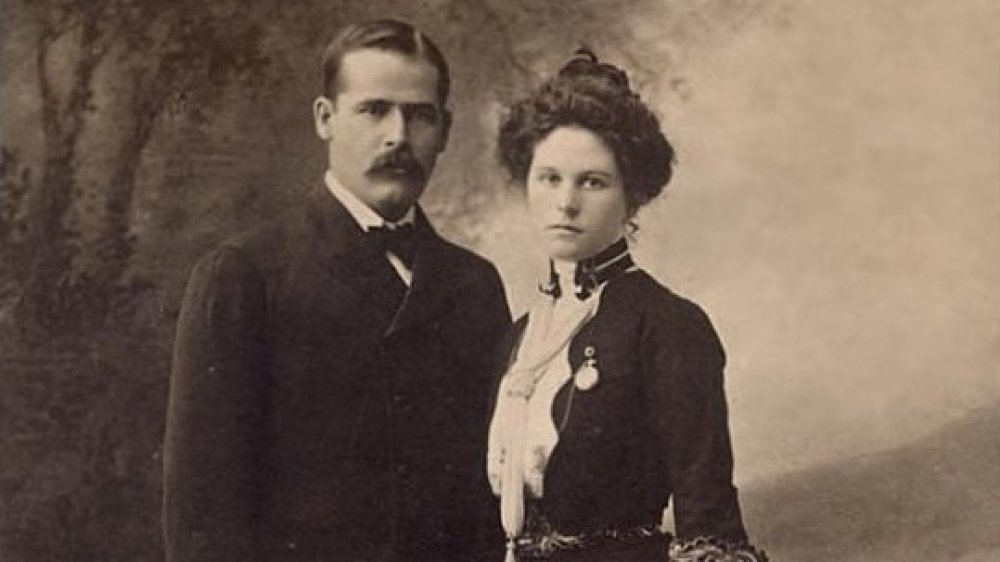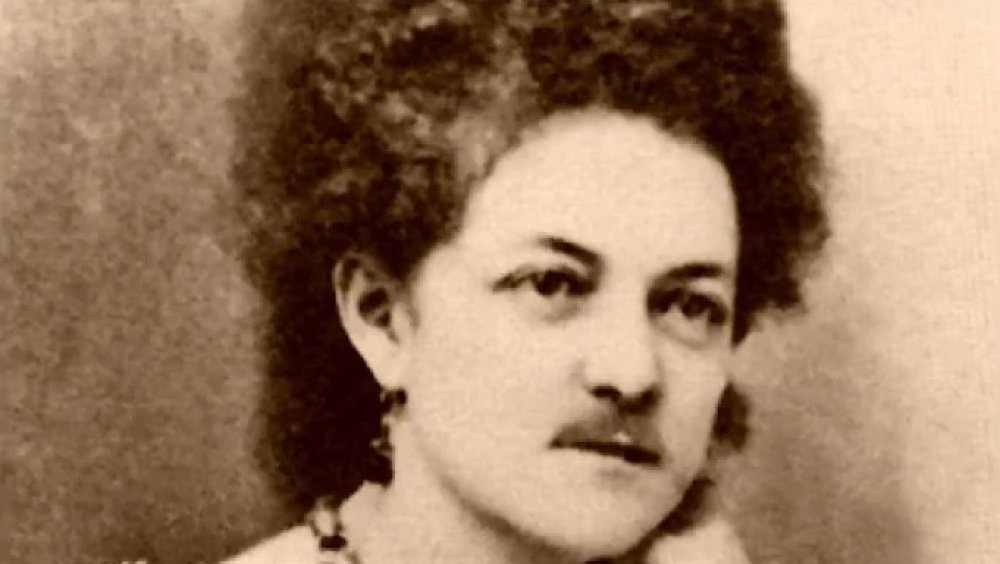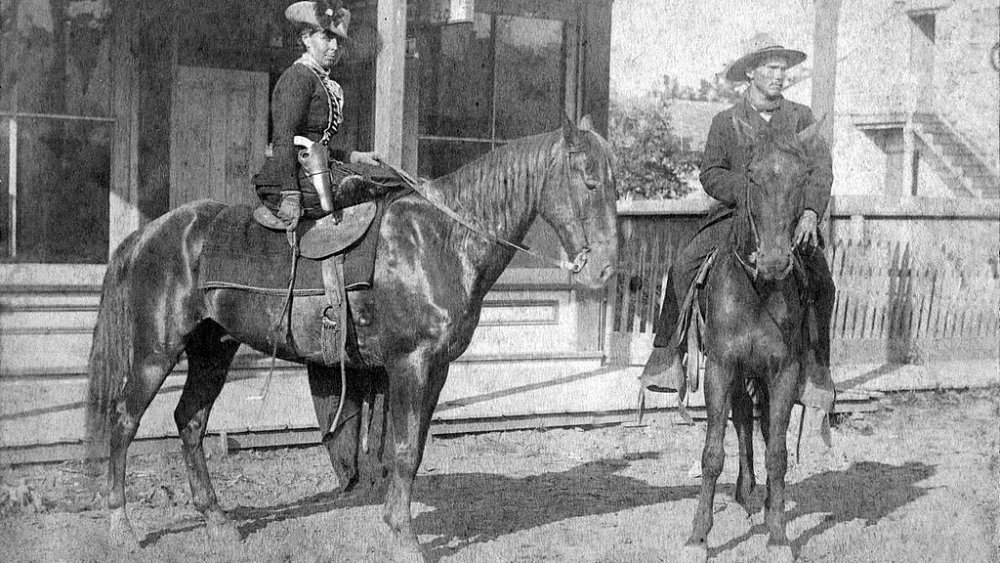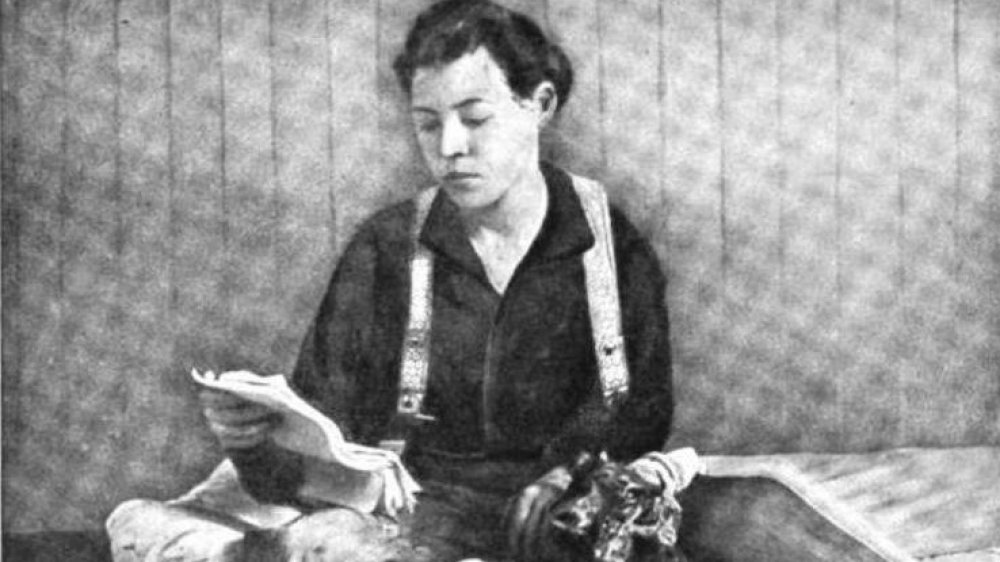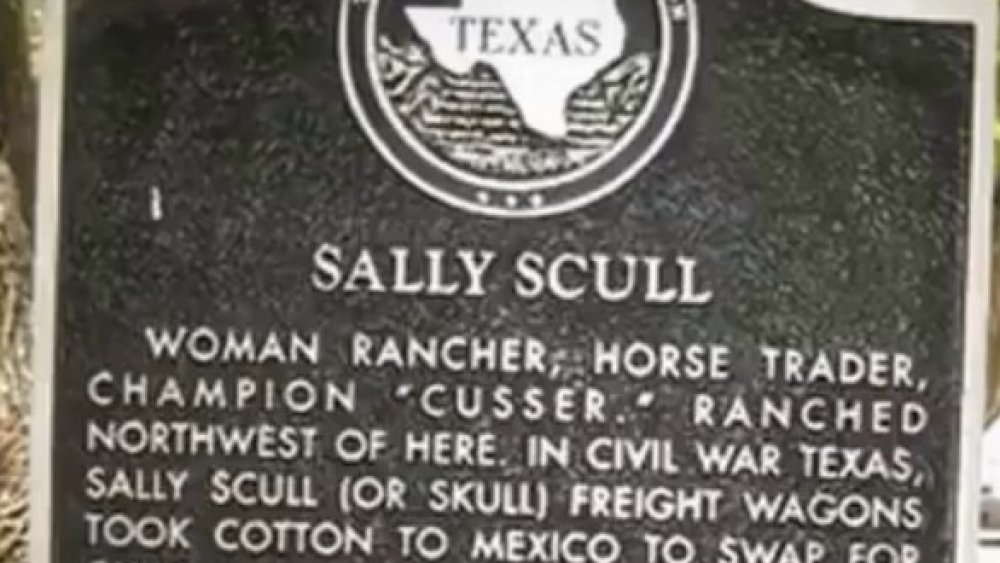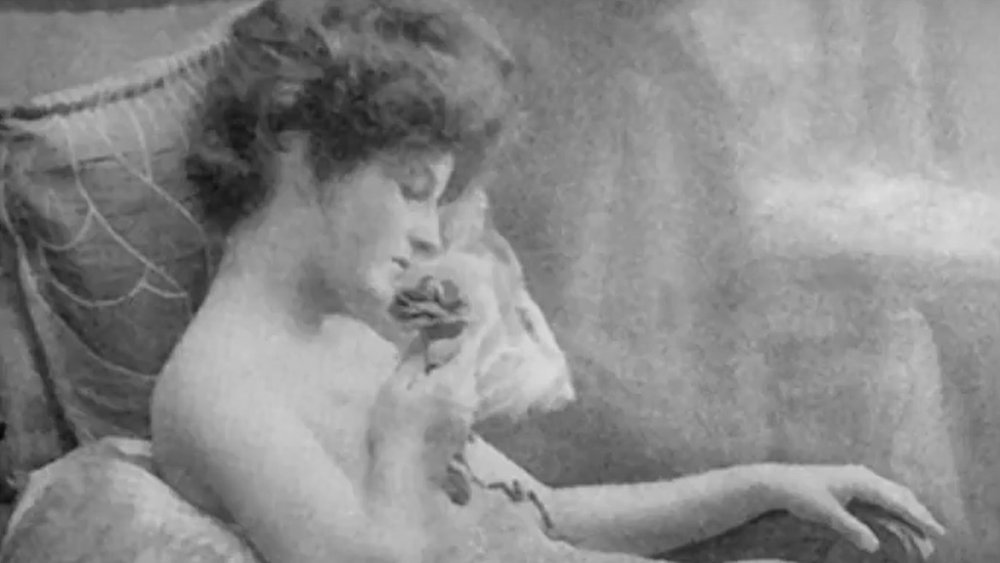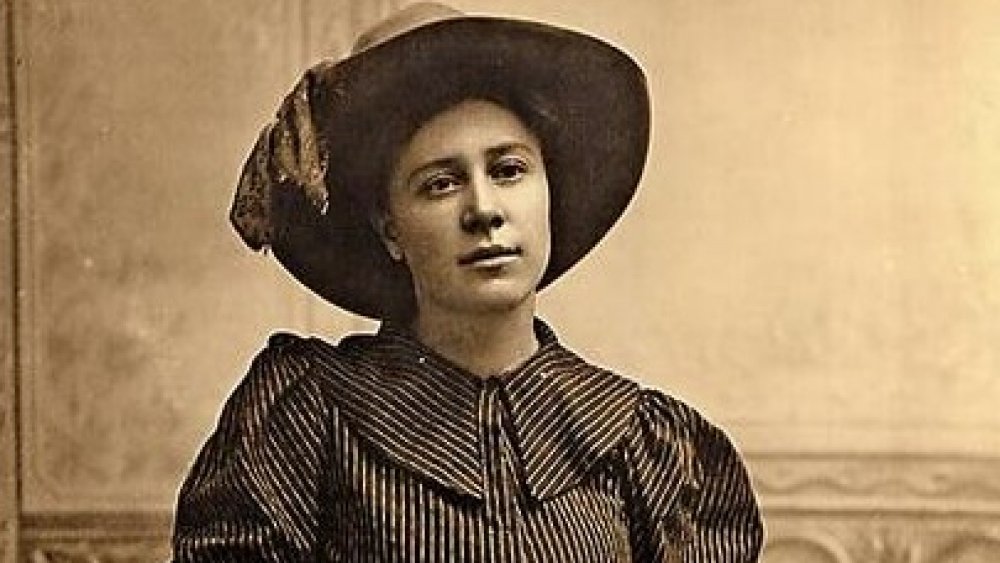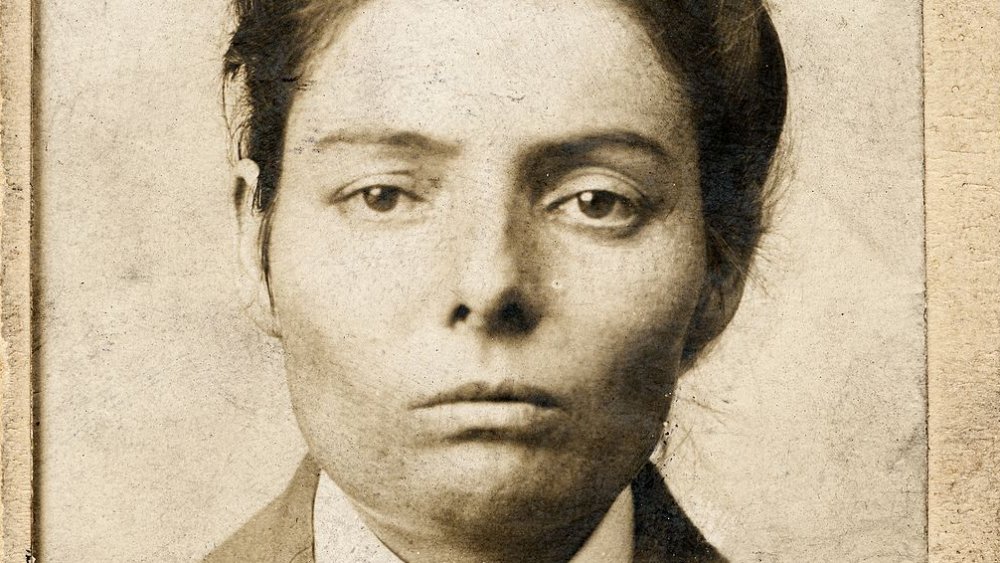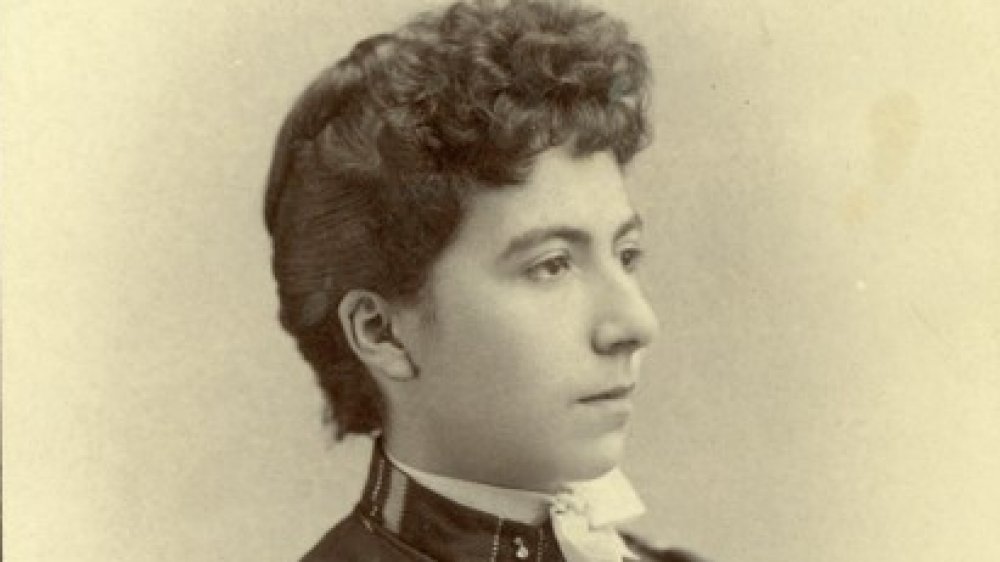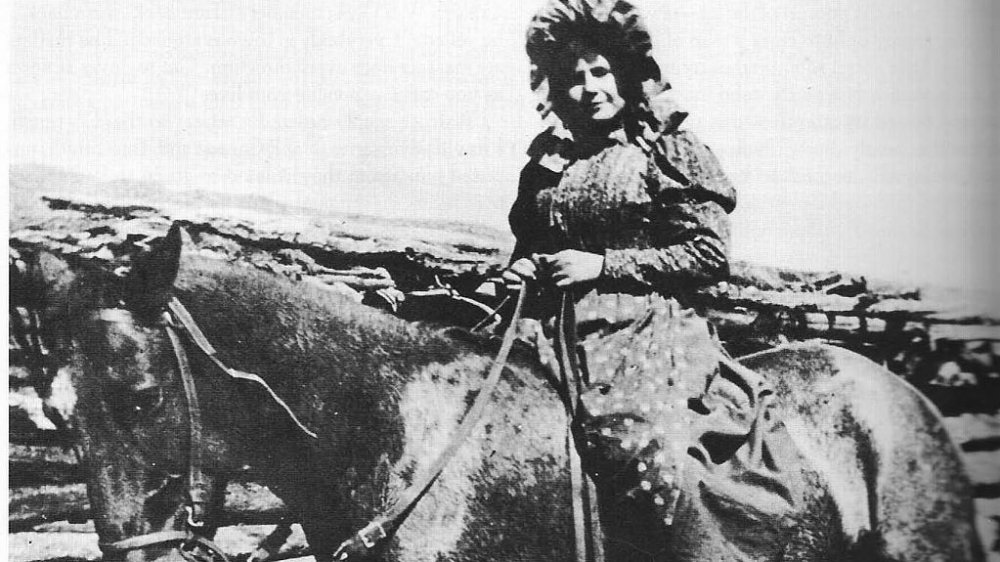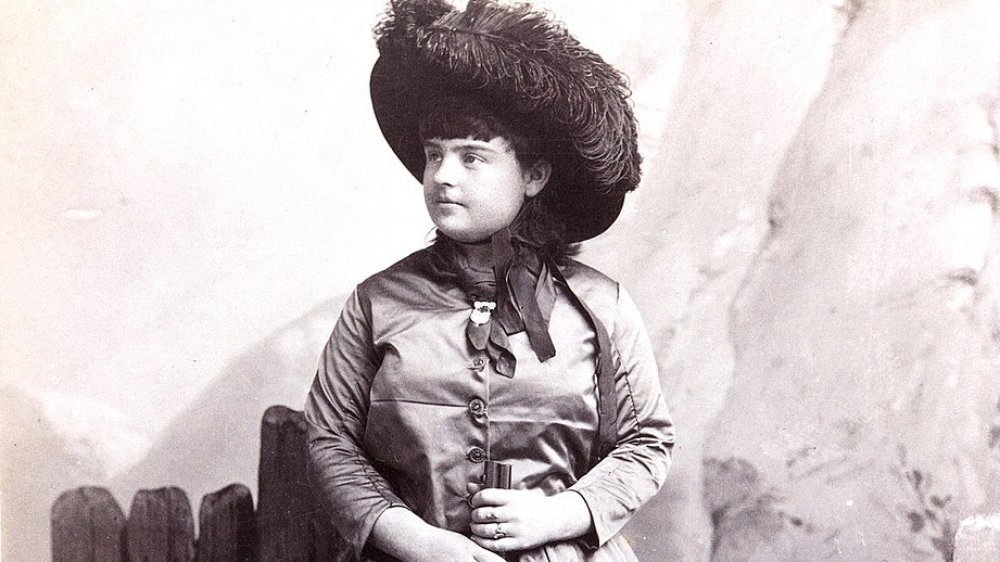The Truth About The Wild West's Female Outlaws
The American frontier of the late 1800s is called the Wild West for a reason. Shortly after the Civil War until nearly the turn of the century, men and women flocked to the large swathes of untamed land west of the Mississippi in pursuit of freedom and fortune, not necessarily law and order. In the many rough-hewn towns that cropped up around gold claims, silver seams, and oil wells — think Deadwood, Dodge City, Cripple Creek, Tombstone — it wasn't hard to find a card game or a drink or a "sporting woman." If you weren't quick on the draw, you could soon count yourself among the less quick and the very dead. At least that's what Hollywood would have us believe. And in the most popular Hollywood depictions of the Wild West, men are almost always the stars of the show. There's Wyatt Earp, right? And his buddy, Doc Holliday, not to mention Jesse James, Butch Cassidy and the Sundance Kid, and Billy the Kid. So much for men and kids. What about the women?
The truth is that the women of the Wild West were often just as unruly and bold and fearless as their male counterparts. And they often had a bad-ass nickname to prove it. Read on for more about some of the frontier's most notorious females.
"Big Nose" Kate Horony, aka Mrs. Doc Holliday
Mary Katherine Horony was often called "Mrs. Doc Holliday" because of her long-standing relationship with the dentist-turned-gun-slinger, but she was much more than just outlaw arm candy — she was a force all her own.
Horony was born around 1850 in what was then Hungary. According to Vintage News, the family moved to Mexico where Horony's father served as the personal surgeon to Emperor Maximilian. When the emperor's government collapsed, the Horonys packed up and moved to Iowa. Soon, Kate was orphaned, and, after a tragic marriage (she lost both her husband and child to fever), ended up as a prostitute in Dodge City. That's where she met Wyatt Earp who, in 1875, introduced her to Doc Holliday. She and Holliday fell head over heels in love. Such was Horony's devotion that when Holliday was arrested for stabbing a man over a card game, she set fire to a shed to create a distraction. Then, the Tombstone Times reports, she threatened to shoot Holliday's jailer if he didn't free him. Spoiler alert: he freed him.
The pair eventually ended up in Tombstone, where Holliday took part in the infamous gunfight at the O.K. Corral. Horony wasn't in Tombstone at the time — Holliday, concerned about her safety, sent her away — and their love affair petered out. Horony died at age 89 in the Arizona Pioneer Home.
Etta Place, the Outlaw Queen
Beautiful, refined, intelligent — Etta Place was a triple threat when she met Harry Longabaugh and Robert Leroy Parker, the outlaws known as The Sundance Kid and Butch Cassidy, respectively, at a San Antonio brothel around 1900. Many of the details of Place's life have been lost to time. Some historians suggest Place and another famous loose lady linked to Longabaugh, Parker, and their Wild Bunch, Ann Bassett, might have been one and the same person.
Much of what's been written about her is conjecture and hearsay. Rumor was she often held the get-away horses while Longabaurgh and Parker robbed banks, trains, and stagecoaches. She might have even fended off an entire posse on her own. What is known, though, according to the book, Red Light Women of the Rocky Mountains, is Place became not only Longabaugh's companion and lover but also an accomplice to his and Parker's life of crime. Shortly after meeting the two men, she fled with them to Argentina and even participated in a bank robbery there. Longabaugh and Parker were eventually shot dead by the Bolivian cavalry. It's possible that Place, too, was killed in the same operation. Either that or she returned to the American West to work as a prostitute until her death. Or a teacher. Or a soldier in the Mexican-American War. Either way, props to the Outlaw Queen.
Eleanor Dumont, or Madame Mustache
Don't let the facial hair fool you. Eleanor Dumont was, in her early years as a blackjack dealer in mid-1800s San Francisco, as feminine they came. According to this look at her life story, Dumont dressed well and kept her hair piled high. Born in New Orleans in 1828, she moved to California when she was 21 and quickly earned a reputation as a crafty card player. Perhaps too crafty. She was eventually fired from the Bella Union saloon on suspicion of card sharping.
No matter. Dumont had a bunch of cash with her when she skipped town for Nevada City. There she opened up her own saloon, Vingt-et-un, named for her favorite game. Soon, miners were flocking to her tables. And they did their best to seduce her, too. Dumont, though, would not be won, not until she'd left Nevada City for Carson City where she purchased a ranch and fell in love with a man named Jack McKnight. But McKnight was a swindler. He sold the ranch and pocketed the profits. So she shot him dead.
Dumont's latter life is a sad study in gradual decline. Having grown a pronounced line of hair on her upper lip, she suffered the indignity of being nicknamed "Madame Mustache." Worse yet, her card playing abilities deserted her. One night in 1879, she took a bottle of red wine and a dose of morphine and walked alone out of town. She was found dead the next morning.
Belle Starr, the Bandit Queen
Belle Starr didn't seem destined to be an outlaw. She was born Myra Maybelle Shirley in Carthage, Missouri to wealthy parents and what seemed like a prosperous future, but then the Civil War wiped out her family's fortune and they moved to Texas to start over. Belle, who'd worked as a scout and spy for the Confederacy during the war, soon took up with the wrong crowd — the James-Younger gang to be exact, not to mention the criminal Jim Reed, who would eventually become her husband.
As this Atlas Obscura piece shows, Reed was an inveterate horse thief and bank robber. He dragged Belle all over Texas, California, and Indian Territory, evading the law, murdering men, and, in general, getting into trouble. As a young mom, Belle aided and abetted her husband, but there's little proof that she actively participated in his crimes. It wasn't until Reed's death in 1874 when she took up with Sam Starr, a part-Cherokee outlaw, that her life as the Bandit Queen truly began. She and Sam claimed a 1000-acre ranch in Oklahoma and often played host to Jesse James and other wanted men. She stole horses, ran liquor, and spent a short time in jail for horse theft and boot-legging. In 1886, Sam Starr was killed by a rival, and Belle lost her taste for crime. She was shot while on horseback in January 1889.
Pearl Hart, the stage coach robber with a heart of gold
Pearl Hart, nicknamed the Arizona Bandit, robbed stage coaches the way some people write emails — like it was her job. And it was her job, starting in May of 1899 when, desperate for money to send home to her young son, Hart, along with her lover, Joe Boot, decided to hold up the Globe to Florence coach. According to History, Hart, dressed as a man, walked away from the robbery with $418 in cash. It would have been $421, but Hart felt bad for the passengers and gave them each a $1 so they could purchase something to eat in town. The law caught up with both Hart and Boot and they were sent to jail. Hart then charmed some guards into helping her escape, but she was caught soon afterward.
Boot was sentenced to 30 years. Hart, though, was acquitted. This infuriated the judge, who sentenced her to seven years for stealing the stage coach driver's pistol. Then, awkwardly enough, Hart got pregnant in prison and, as a way to save face, the governor of Arizona pardoned her in 1902. Her life afterwards is hard to pin down. Some say she became an actress, others a player in Buffalo Bill's Wild West Show. Still others say she settled down with rancher Calvin Bywater and became, in the words of her neighbors, "soft-spoken, kind, and a good citizen in all respects."
Sally Scull or Sally "Skull" if you're nasty
Before Sally Scull became one of the most feared wives on the frontier, she was simply Sally Newman, born in 1817 in Illinois. Six years later, her family moved to Texas where Sally got her first taste of just how brutal life on in the Wild West could be. According to this editorial in My Plainview, she once watched impressed as her mother chopped off the toes of a Native American man who'd slid his foot under their cabin door. Young Sally would shame a neighbor for not confronting an Indian invader, demanding he give her his gun — she could do it herself.
In 1833, after witnessing his heroics in a war with local tribes, Sally married Jesse Robinson. Robinson got out alive after 10 years of marriage. Her next three husbands — George Scull, John Doyle, and Isaiah Watkins — were not so lucky. All died under mysterious circumstances. As this piece from the Texas Folklore Society shows, Scull became so famous for dead mates that mothers often used her as a threat to reign in their naughty children, saying, "You better be good or Sally Scull will get you."
No one knows exactly how Scull died, although legend has it her fifth and last husband killed her for her money and buried her in a shallow grave. Others say she moved to El Paso and spent her last years writing her life story. And what a story it is.
Pearl de Vere, the soiled dove of Cripple Creek
Pearl de Vere got her start as a sporting woman in the late 1870s. Born in Chicago and raised in Indiana, she moved west to make a buck off the backs of lonely men. According to Naked History, de Vere arrived in Denver as Mrs. Isabel Martin. There was no Mr. Martin as far as anyone could tell. Denver treated de Vere well until the Silver Panic of 1893, when she decided to take her chances on the boom town of Cripple Creek. She set up her own brother in the town's red light district and soon began doing very good business. Catering to Cripple Creek's well-to-do, she made sure the young women in her employ were healthy and looked after.
As this article in the Mountain Jack Pot News makes clear, de Vere's family back in Indiana were convinced she was working not as a madame but as a dress maker, and she did try to attain at least a level of respectability, marrying mill owner in C.B. Flynn in 1895. Then, when a fire swept through town, taking her brothel and his mill with it, the marriage effectively dissolved. Flynn moved to Mexico. De Vere remained in Cripple Creek and opened up another entertainment establishment, one she called the Old Homestead. After a fabulously decadent party in June 1897, de Vere retired to her room and, finding she couldn't sleep, took some laudanum. She was found dead the next day.
Rose Dunn, the Rose of Cimarron
Rose Dunn was born to a family of ne'er-do-wells. According to this Legends of America profile, Dunn's brothers introduced her to the Dalton Gang, a crime syndicate operating in Kansas in the early 1890s, and to George "Bitter Creek" Newcomb, thereby sealing Dunn's fate. She fell in love with Newcomb, who later joined the Doolin gang, and soon she was up to her petticoats in crime and intrigue.
Everything came to a head on the afternoon of September 1, 1893 when the Dalton gang, holed up in a saloon, engaged in a gun fight with U.S. marshals in Ingalls, Oklahoma. Dunn reportedly ran through a hail of bullets to deliver a Winchester rifle to Newcomb, lying prone on the ground. Some reports suggest she fired a number of shots before handing Newcomb the gun. Can you say "relationship goals?" Two years later, Dunn's brother's sold Newcomb out to authorities and he was killed.
It was Newcomb who gave Dunn her nickname. He called her the Rose of Cimarron in homage to her beauty and grace under pressure. Dunn later went on to marry a respected Oklahoma politician. She lived the rest of her life in mundane respectability.
Laura Bullion, the Rose of the Wild Bunch
Like Etta Place, Laura Bullion found herself at the center of some of the Wild Bunch's most nefarious deeds. Born to outlaw Henry Bullion, according to Women's History Network, she began her life of crime at 13-years-old when she first met Ben Kilpatrick, aka the Tall Texan, and William Carver of Butch Cassidy and Sundance's lawless gang. She was welcomed into the bunch with open arms, forging signatures and taking part in robberies, and the members dubbed her "the Rose of the Wild Bunch."
Shortly after the Wild Bunch's robbed the Great Northern train in July 1901, making off with $60,000, Bullion was arrested with $8,500 worth of banknotes on her person. She served two and a half years in prison. As this short biographical note that accompanies her mugshot in the the National Portrait Gallery illustrates, she was cool and fearless at the time of her arrest. She later moved to Memphis, Tennessee and lived under an assumed name as a seamstress and housekeeper until her death at age 85.
Josephine Sarah "Sadie" Marcus was Wyatt Earp's partner
As Wyatt Earp's common-law wife, Josephine "Sadie" Marcus was a witness to history and often helped make it. As this Jewish Women's Archive profile shows, Marcus was a rebel from a very young age. At 17, if her accounts of her youth can be believed, she ran away from home to join a theater troupe. Then, defying her parents' wishes yet again, she moved to Tombstone, Arizona to be closer to her sweetheart, divorced ladies' man, Johnny Behan. It was in Tombstone that Marcus met Wyatt Earp, who was likewise attached. Love like theirs could not be stopped by anything as inconvenient as having other partners, and the two were romantically linked when the gunfight at the O.K. Corral threw Tombstone into chaos on the afternoon of October 26, 1881. Marcus stood by her man as he visited vengeance on the men he blamed for killing his brother, Morgan.
Marcus' biographer describes her as an unforgettable beauty, a cross between Dolly Parton and Penelope Cruz — "all curves and curls and wit" — and Earp, known for his wandering eye, remained with her until his death in 1929.
Ellen Liddy Watson, the lady otherwise known as "Cattle Kate"
Not all the bad-ass women of the Old West were outlaws. Some are just very strong ladies who did everything they could to prosper under incredibly harsh conditions. One such lady was Ellen Liddy Watson. Born in Ontario, Canada, Watson moved with her family to Kansas in 1877. According to TheWildWest.org, Watson was married to a local farmer at the tender age of 16. Her husband beat her and she fled to her parent's homestead. A series of moves followed, first to Red Cloud, Nebraska, then to Denver, and finally to Rawlins, Wyoming where she found work as a cook and a waitress.
It was in Rawlins that she met her future partner, Jim Averell. He invited her to move in with him and she did. Watson was independent, though, and preferred to have her own home. She soon bought her own ranch. Area cattlemen were unhappy with the fact that Watson owned so much land — land that they were used to using for their own cows — and they resented the fact that Watson and other mid-level ranchers had successfully pressured authorities into passing a law that put an end to an exploitative practice in which rich ranchers effectively stole the cattle of poorer ones. The cattlemen had their eye on Watson, whom they derisively referred to as "Cattle Kate." On July 20, 1889, they arrested her on trumped-up charges of cattle rustling and lynched her.
Lillian Smith was not a Native American
Lillian Frances Smith was most known for being a rival of Annie Oakley's in Buffalo Bill's Wild West traveling show, but, like so many rebellious frontier women, she was not defined simply by the famous people who surrounded her, or, indeed, the men who tried to capitalize on her talent.
Smith got into sharp shooting thanks, in part, to her controlling and mercenary father. He saw the potential to make money off his daughter's uncanny knack for shooting glass balls out of the air, and soon Smith was on the road, entertaining audiences not just with her gun play but with a faux Native American persona. According to this piece in Great Plains Quarterly, she joined Wild Bill Cody's troupe at age 14, and a few years later started calling herself "Wenona" and passing as an Indian princess. Smith, who threw herself into the offensive role of a flirty and brash Indian with a drinking problem, was the foil to the more Victorian and proper Oakley.
Smith was eventually forced out of the show, probably, as Smithsonian Magazine suggests, by a jealous Oakley, and she began touring on her own, falling in and out of love with different men and taking her Indian princess act to Hawaii, the East Coast, and the World's Fair. When she died in 1930 at the age of 59, she was buried in full Sioux garb.
